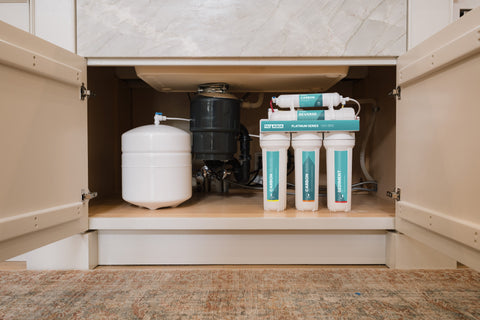Access to clean and safe drinking water is crucial for maintaining good health and well-being. However, water sources can be susceptible to various contaminants that pose potential risks to human health. Understanding the different types of water contaminants is essential for ensuring water safety and making informed decisions about water treatment and filtration methods. In this blog post, we will explore the common types of water contaminants, their sources, and the potential health effects they can have.
Common Water Contaminants
Water contaminants can be broadly classified into three categories: microorganisms, chemical contaminants, and physical contaminants. Let's take a closer look at each of these categories to better understand the specific types of contaminants found in water sources.
Microorganisms
Microorganisms are living organisms that can be present in water sources, and some of them can cause serious illnesses when ingested. The following are the primary types of microorganisms that contaminate water:
-
Bacteria: Bacterial contaminants, such as Escherichia coli (E. coli) and Salmonella, are commonly found in water sources contaminated with fecal matter. These bacteria can cause gastrointestinal illnesses, leading to symptoms like diarrhea, abdominal pain, and vomiting. In severe cases, bacterial infections can even be life-threatening, particularly for vulnerable populations like children, the elderly, and individuals with weakened immune systems.
-
Viruses: Waterborne viruses like norovirus and rotavirus are highly contagious and can cause gastroenteritis, resulting in symptoms such as nausea, vomiting, diarrhea, and fever. Viral contamination often occurs due to inadequate sanitation practices or contaminated water sources. It is essential to note that viruses are not eliminated by chlorine alone, the most common disinfectant used in water treatment, necessitating additional treatment measures.
-
Protozoa: Protozoa are single-celled parasites that can be found in water contaminated with human or animal feces. Common protozoan contaminants include Giardia and Cryptosporidium. Ingesting water contaminated with these parasites can lead to gastrointestinal illnesses, causing prolonged diarrhea, abdominal cramps, and dehydration. Protozoan infections can be particularly challenging to treat, requiring medical intervention.
Chemical Contaminants
Chemical contaminants in water can originate from various sources, including industrial activities, agricultural practices, and household waste. These contaminants can have long-term health effects on human beings. Here are some prominent chemical contaminants found in water:
-
Heavy Metals: Heavy metals like lead, mercury, arsenic, and cadmium can leach into water sources from natural deposits, industrial discharges, or deteriorating infrastructure (such as lead pipes). Prolonged exposure to high levels of heavy metals can lead to organ damage, neurological disorders, developmental issues, and even certain types of cancer. Infants and young children are especially vulnerable to the toxic effects of heavy metal contamination. The NU Aqua reverse osmosis systems filters heavy metals for a better and safer water.

-
Pesticides and Herbicides: Agricultural activities often involve the use of pesticides and herbicides to protect crops. These chemical compounds can find their way into water sources through runoff or infiltration. Prolonged exposure to pesticide-contaminated water can contribute to various health problems, including hormonal disruptions, reproductive issues, and certain types of cancer.
-
Industrial Chemicals: Industrial processes can introduce a wide range of chemical pollutants into water bodies. Persistent organic pollutants like polychlorinated biphenyls (PCBs) and dioxins are known to accumulate in the environment and have detrimental effects on human health. Exposure to industrial chemicals through water consumption can lead to developmental disorders, hormonal imbalances, and an increased risk of certain cancers.
Understanding the different types of chemical contaminants is essential for assessing water quality and implementing appropriate treatment measures to remove.
Physical Contaminants
Physical contaminants affect water quality and clarity. Here are some common physical contaminants found in water:
-
Sediments and Suspended Solids: These can have adverse effects on aquatic ecosystems and human health.
-
Turbidity: High turbidity levels can impact water clarity and indicate the presence of contaminants.
-
Radioactive Materials: Presence of radioactive contaminants in water can pose serious health risks.
Sources and Prevention
Now that we have familiarized ourselves with the common types of water contaminants, it is crucial to understand their sources and explore preventive measures that can help ensure the safety of our water sources.
Agricultural Activities-
Contaminant Sources: Agricultural practices, such as the use of fertilizers, pesticides, and herbicides, can contribute to water contamination. Animal waste from livestock operations can also introduce pathogens and nutrients into nearby water bodies.
-
Prevention: Implementing best management practices in agriculture can significantly reduce water contamination risks. This includes practices such as proper storage and handling of chemicals, precision application of fertilizers and pesticides, and the implementation of buffer zones to prevent runoff into water sources. Promoting sustainable farming methods, such as organic farming and integrated pest management, can help minimize the use of harmful chemicals.
Industrial Processes
-
Contaminant Sources: Industrial activities, such as manufacturing, mining, and waste disposal, can release various pollutants into water bodies. Industrial discharges often contain heavy metals, toxic chemicals, and other harmful substances that can contaminate water sources. Improper disposal of industrial waste can lead to long-lasting pollution and pose significant risks to human health.
-
Prevention: Stringent regulations and effective enforcement are essential in controlling industrial water pollution. Industries must implement proper wastewater treatment processes to remove or neutralize contaminants before discharging the water. Promoting the use of cleaner production technologies and adopting sustainable practices can help reduce the release of pollutants into water bodies.
Domestic Sources
-
Contaminant Sources: Improper disposal of household chemicals, inadequate septic system maintenance, and inadequate wastewater treatment can introduce contaminants into water sources. Aging infrastructure, such as corroded pipes, can also lead to the leaching of heavy metals into the water supply.
-
Prevention: Individuals can take proactive steps to prevent water contamination from domestic sources. Proper disposal of household chemicals through designated collection programs or hazardous waste facilities is crucial. Regular maintenance and inspection of septic systems can prevent leaks and contamination of groundwater. Upgrading and replacing old plumbing infrastructure, particularly lead pipes, can also help mitigate the risk of heavy metal contamination.
Water Treatment and Filtration
-
Water Treatment Methods: Water treatment plays a vital role in removing or reducing contaminants to ensure safe drinking water. Common treatment methods include coagulation and flocculation, sedimentation, filtration (such as activated carbon and reverse osmosis) and disinfection (typically using chlorine or ultraviolet light).

- Contaminant-Specific Filtration: Different types of contaminants require specific filtration methods for effective removal. For example, activated carbon filters are efficient in removing organic compounds and chlorine byproducts, while reverse osmosis systems are effective in eliminating heavy metals, salts, and microbial contaminants. Understanding the specific contaminants present in your water source can help in selecting the appropriate filtration system.
Conclusion
Understanding the different types of water contaminants is crucial for ensuring clean and safe drinking water. Microorganisms, chemical contaminants, and physical contaminants can all pose health risks when present in water sources.
Identifying the sources of water contamination, such as agricultural activities, industrial processes, and domestic practices, is essential for effective prevention. Implementing best management practices, enforcing regulations, and adopting responsible household practices can help reduce contamination risks.
Investing in appropriate water treatment and filtration systems tailored to specific contaminants is important for removing harmful substances. Choosing the right treatment methods, such as coagulation, filtration, disinfection, and advanced processes, can provide an additional layer of protection.
Regular water testing, preventive measures, and advocating for sustainable practices are vital for preserving and protecting our water sources. By taking these steps, we can contribute to a healthier, safer world with clean and safe drinking water for ourselves and future generations.
For more information on water filtration systems and sustainable solutions, you can visit our website at www.nuaquasystems.com.



